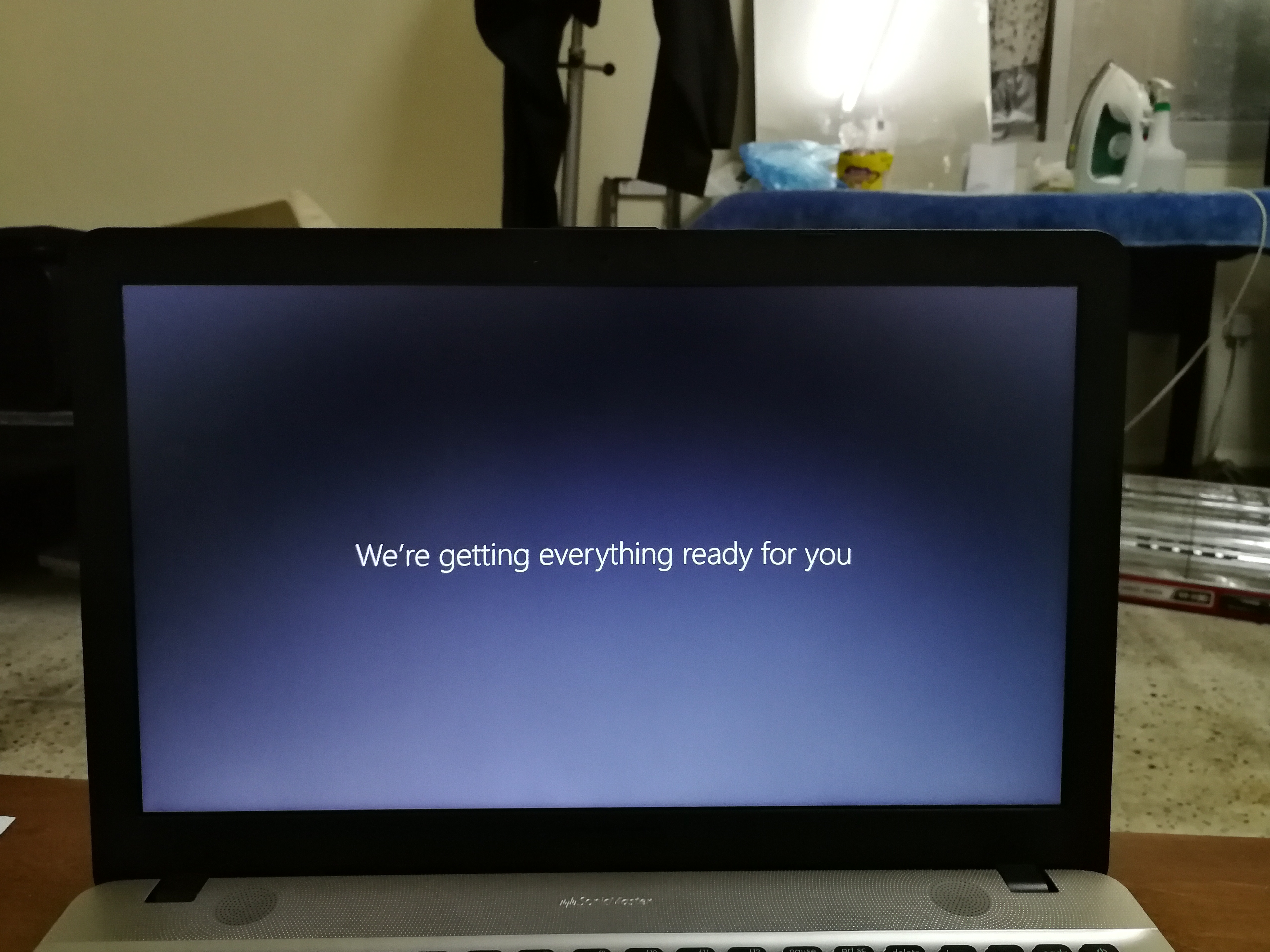Getting Windows Ready Loop Windows 10
21.09.2019 admin
Windows stuck at getting ready screen after windows update installation or Recent windows 10 October 2018 update?Here every possible solution to fix windows 10 getting ready loop or getting windows ready every reboot, getting windows ready don’t turn off your computer etc on windows 10, 8.1 and 7. Dec 07, 2017 Each new update of Windows is making Windows OS better. After Windows 7, Windows 10 is the best windows by Microsoft. But Microsoft made few major changes in Windows 10 and removing “Turn Off Automatic Update” option is one of them.Yes, you can stop auto updates in Windows 10 but not everyone knows how to do it. And the automatic update is the reason behind “Getting Windows Ready. If when you are upgrading your Windows 10 computer or laptop to a newer version, it is stuck on Getting Windows ready, Don’t turn off your computer screen, then this post is sure to interest you.
The “Getting Windows ready, Don’t turn off your computer” message appears while Windows is installing updates. Windows will normally finish the installation process if you give it time—but, if it’s been hours, you may just need to restart your PC.
Unfortunately, it’s normal to wait a while for Windows to update, and this wastes an immense amount of time. Microsoft says there are about 700 million Windows 10 devices and that the April 2018 Update will take 10 to 30 minutes to install. So, assuming an average of 20 minutes for 700 million computers, that’s over 26,000 years of humanity’s collective time wasted waiting for Windows 10 to install a single update.

What Happens If You Restart Your PC?
The update installation process will fail if you restart your PC during this process. But how badly will it fail? Will it cause problems with your computer? To find out exactly what happens, we ran some tests.
First, we told Windows to install a standard update from Windows Update. We forcibly restarted our PC while the “Getting Windows ready. Don’t turn off your computer” message appeared on the screen. The PC restarted and we quickly saw the normal sign-in screen.
After we signed in, Windows displayed a “We couldn’t finish installing updates” notification. The update installation had failed, but Windows was still working properly. Windows will just try installing the update later.
Second, we restarted our PC while the screen said “Working on updates, 27% complete, Don’t turn off your computer.”
Windows restarted normally and we saw a message saying “We couldn’t complete the updates, Undoing changes, Don’t turn off your computer.” After the process was complete, Windows booted normally and everything worked as expected.
We also tested this process while installing a major Windows 10 update, going from the Fall Creators Update to the April 2018 Update. We rebooted our computer when the message “Configuring update for Windows 10, 10% complete, Do not turn off your computer” appeared on our screen.
After the computer restarted, we saw a simple “Please wait” message, and then the sign-in screen appeared normally. Once again, we saw the “We couldn’t finish installing updates” notification.
Finally, we tried restarting the PC when it said “Working on updates 48%, Don’t turn off your PC. This will take a while.” A “Restoring your previous version of Windows…” message appeared as Windows rolled back the update, and our PC booted and worked normally afterwards.
In every test, turning off the computer didn’t cause any problems. Windows just decided to stop updating and roll back any files that were updated. Windows does insist on re-downloading the update before trying to install it again, just in case there was a problem with the download. The updates then installed normally afterwards.
How Long Should You Wait?
Be patient and give Windows some time to finish installing updates if this message appears on your screen. Depending on how big an update Windows has to install and how slow your computer and its internal storage are, this process could take a while to complete.
It’s common for this message to appear on your screen for up to five minutes. However, if this message has appeared on your screen for a long time, you may need to restart your PC. We recommend waiting two hours, just in case Windows is doing a lot of work. Windows may just need some time to finish the process, especially if it’s a big update and your hard drive is slow and full.
If you see a percentage number on your screen and it’s increasing, leave Windows alone as long as it appears to be making progress. If the percentage appears stuck on a particular number for a long time, the update process may be stuck. However, it’s normal for Windows to appear “stuck” at a particular point for a long time before speeding through the rest of the installation process, so don’t be too impatient.
Yes, You Should Turn Off Your Computer If It Gets Stuck Here

As we’ve shown above, restarting your PC should be safe. After you reboot, Windows will stop trying to install the update, undo any changes, and go to your sign-in screen. Windows will try reinstalling the update again later, and it should hopefully work the second time. This shouldn’t be necessary, but Windows has bugs, and sometimes you have to restart your PC to fix them. This is true even when Windows is telling you not to turn off your computer.
To turn off your PC at this screen—whether it’s a desktop, laptop, tablet—just long-press the power button. Hold it down for about ten seconds. This performs a hard shut down. Wait a few seconds, and then turn your PC back on. Performing a hard shut down is never ideal, but it may be your only option in cases like this.
Warning: While we’ve successfully tested this process, there are no guarantees that your Windows operating system will work properly after you perform a hard shut down. However, if the update process is actually frozen, performing a hard shut down is the only thing you can do. We recommend always having backups of your important personal files, just in case.
RELATED:What’s the Best Way to Back Up My Computer?
How to Repair Windows If It’s Not Working Properly
Simply restarting your computer should fix the problem. However, if your PC still doesn’t start properly, you have another system problem. Restarting your computer may not have even caused the problem—your computer may have gotten stuck at the “Getting Windows ready” message because the Windows operating system already had an error.
You can often use the Startup Repair tool to fix Windows. An advanced boot options menu is supposed to appear when Windows doesn’t boot properly. Select Troubleshoot > Advanced Options > Startup Repair if you see an advanced boot options menu. If the menu doesn’t appear, you can create Windows 10 installation media, boot from it, and then select the “Repair your computer” option.
If even Startup Repair won’t fix your problem, you may need to use the “Reset this PC” feature or even reinstall Windows to get a fresh, functioning operating system.
Windows 10 Getting Windows Ready 2018
If you can boot into Windows, but it doesn’t seem to be running properly, you can also try repairing corrupted system files with the System File Checker (SFC) command instead of reinstalling Windows. You can also try running System Restore to get your operating system back to a known-good state.

If your computer doesn’t perform well even after you reinstall Windows, you probably have a hardware problem instead of a software problem.
RELATED:How to Fix Startup Problems with the Windows Startup Repair Tool
Windows 10 Getting Ready Stuck
Image Credit: hawaya/Shutterstock.com.
READ NEXT- › Windows 10 20H1 Will Let You Drag and Drop With Your Eyes
- › How to Move Google Authenticator to a New Phone (or Multiple Phones)
- › Why Did Your iPhone Beep or Vibrate? Here’s How to Find Out
- › Why You Should Buy AMD’s 2019 CPUs for Your Next PC
- › How to Use the pinky Command on Linux
Hello,
My Lenovo Ideapad Y510P laptop is failing to boot and encountering BSOD shortly after starting laptop (bad_system_config error), so I downloaded the Windows 10 installation media directly from Microsoft onto a USB, then entered boot options and chose to boot from USB to go into Windows 10 setup. I chose custom setup because:
- My laptop already had Windows 10 Home installed before getting the BSOD's
- I'd like to keep my personal files on the non-system drives
Everything went fine until the compute restarted, now it's stuck with the Lenovo logo and 'getting ready' for the last hour which I doubt is normal.
Does anyone know what's causing this and what's the proper way of custom installation via USB? I google'd extensively but can only find info on clean installations where you wipe your entire HD, which is NOT what I want as I need to preserve my personal files, but I don't mind wiping C: drive. Also there was some info about 'legacy BIOS' and 'UEFI' but I have no idea what those are or which one my computer has.
